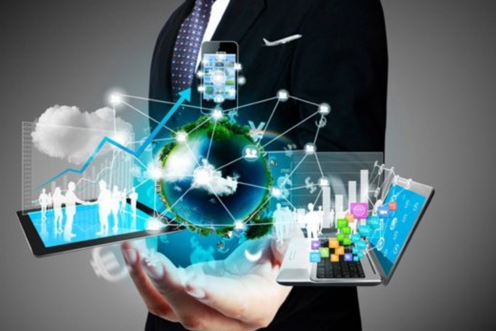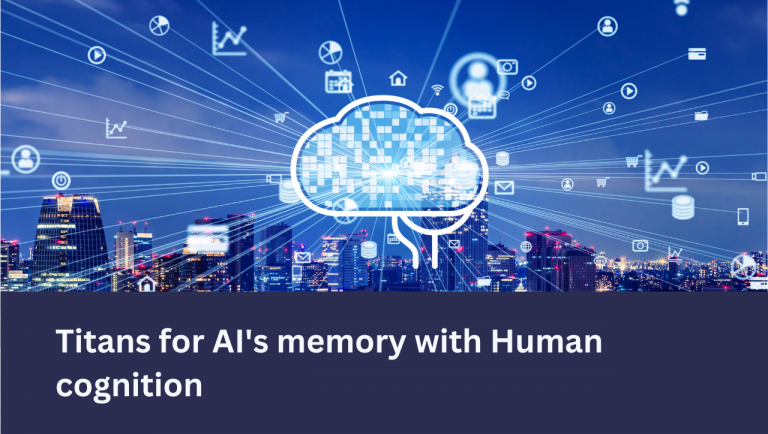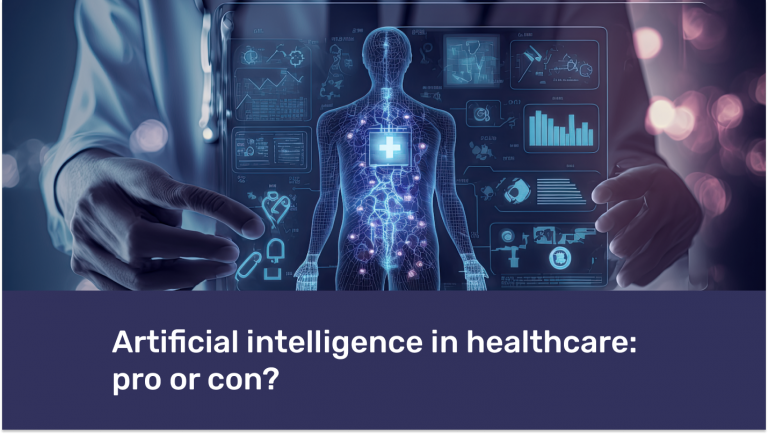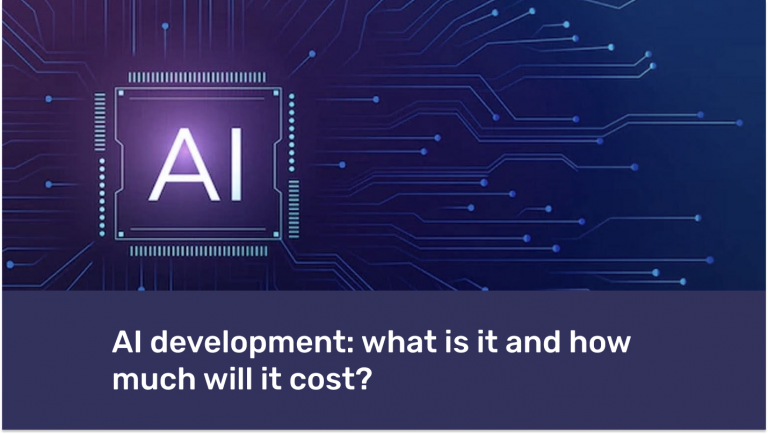Now, we are in the process of a significant transformation, when our material world combines with the virtual one and generates new approaches and business models.
According to the World Economic Forum, robotics and autonomous transport, artificial intelligence, new materials, biotechnologies, and genomics have already functioned in the production process. In simple words, it can be characterized by the computerization of manufacturing or Industrial Revolution 4.0.
What is the technological revolution?

We’re rapidly reaching a point where human performance is being outrun by computer performance. We’re starting to see the ability of computers to do things that are only able to do by humans before, so we’ve called it the Fourth Industrial Revolution. It is bringing together the physical and digital world and adding intelligence to top of it. Industrial 4.0 connects things that we know and we are learning in our practice, in our brains, and transferring that to the computers to do on our behalf.
Industry 4.0 is not a new technology, it’s the applications of digital technologies to our world that gives us the opportunity to change the way that we live and work. It isn’t just about automating the processes or taking what we do as a business and putting it online, that’s all the Third Industrial Revolution. The Fourth technological revolution is about saying is there another way to do these things faster.
How the Industrial Revolution 4.0 distinguishes from previous stages?
Firstly, the pace of development. As each successive innovation creates an increasingly efficient technology, the revolution is developing exponentially. Never before in the history of mankind changes have been so rapid.
Secondly, the dimension of changes. The real and the virtual world penetrate each other, giving birth to breakthrough solutions. Consequently, completely different technologies are combining with each other. Systems become even more complex and integrated. Transformations occur vertically and horizontally. As a result, all levels are affected: man, society, state, the world.
Thirdly, whole systems change. Technologies affect internal and external components of systems. We have to revise the basic concepts: power, money, partnership, relationships, property, and identity.
In addition to the advantages, Industrial Revolution 4.0 carries some threats, such as increasing inequality and social polarization due to global changes in the labour market. These changes will affect the well-being of people.
Not all companies with a long history will survive in this process of digital transformation. About 52% of Fortune 500 companies in 2000 are no longer available today. However, those that transformed will have twice as much gain: consumers are loyal to brands they respect and are ready to stay with them if they go into an individual format.
Total automation of production. The fourth industrial revolution provides complete automation of all processes and stages of production. Now it becomes possible for manufacturers to order all necessary components, control delivery as well as track finished products, setting up this process through an automation system. In this way, everything is produced now: from “smart” pans to laptops.
Previous classical model, companies usually sell their goods and then forget about them. However now, after-sale behaviour has been changed: producers try to extend their communication with clients by controlling terms of product use, changing settings remotely, updating software, as well as taking the product for disposal at the end of the cycle. For example, Apple actively implants this strategy through a program of old iPhones processing: robots disassemble them, remove the most valuable parts and use it in the production of new smartphones.
Therefore, the concept of “Industry 4.0” means an unceasing interaction between 3 elements: manufacturer, product, and client. This interaction becomes possible due to the full automation of the production process.
Uniqueness as a mass product. Now we observe such situations when customers have changed their behaviour, they want an individual approach and unique products. Representatives of the so-called ‘native digital’ generation, who grew up in the Internet age, accustomed to a wide range of proposals: millions of print options on cups, all shades of jeans, any equipment, and furniture at a distance of one click. For this reason, people try to emphasize their individual peculiarities and express their mood, or in other words, to be unique.
Enterprises should produce unique products. The introduction of “Industry 4.0” principles allows obtaining many benefits that were not available in traditional models of the past. For example, now companies try an individual approach by personalizing orders according to clients’ preferences. As a result, these actions promptly increase customers’ loyalty. Old plants and factories turn into “smart” and begin to produce literally unique products on an individual order.
For example, today you can download the Nike application or go to the company’s website, choose a sneakers model, draw it in your favourite colours, pay, and get it in a few weeks. Moreover, it costs about $120 – no more expensive than the usual non-personalized sneakers. The manufacturer is able to offer customers more unique options for their product, which becomes an additional source of revenue and increases the profitability of the business.
Production costs of individual orders at a company with a high level of automation are small: if earlier under each such pair of sneakers it would be necessary to adjust the equipment manually, now the computer system does it on its own in a few seconds. Before most companies built factories in countries with cheap labour forces (as China, for example), now the production process can be organized anywhere due to full automation. So, the fourth revolution changes not only some businesses individually but also affects the allocation of forces at a global level.
6 Revolution Technologies for Fourth Industrial Revolution
Cloud computing
Everything nowadays is moved to the cloud, running in the cloud, accessed from the cloud, or stored in the cloud. Cloud Computing often referred to as “the cloud” is a service that allows people to use online services that are generally available through any device with an internet connection. This means that the user doesn’t need to be at a certain location to access certain data. From computing and analytics to secure and safe data storage, and networking resources, everything can be delivered within no time, thanks to the cloud. The goal of cloud computing is to deliver these services over the internet in order to offer faster innovation, flexible resources, and economies of scale. Have you ever realized that you probably have been using different cloud-based applications every day? Whenever you share an important file over Onedrive with your colleague through the web or use mobile app applications. It’s all about cloud computing. The best part of CC is that it saves money and time.
Internet of Things
IoT is one of the pillars of the fourth industrial revolution with an increase in the adoption of different technologies.
The Internet of Things is a world wide web of interconnected machines and other physical objects, where information can be exchanged without human intervention. So IoT allows physical objects, like doors, chairs, couches to be connected to the internet, or at least to have conversations with things around you.
Let’s take examples of public light. Having light sensors on the light allows the public lights to turn on and off according to the current locations and not to set up time. Also, having sensors in the traffic lights, allows the maintenance team to know when a light is broken. It’s a great way to minimize the amount of time the traffic light is out of service.
IoT technology is widely used in the machine industry. Machine-to-machine communication is something that has been happening for a long time already. Most of the modern machines have different ways to track fuel consumption, the number of hours that the machine is working, GPS tracking, and how long the machine is idle. Also, some of these machines have a lot of sensors inside to track information about engine temperature, pressure, and other operating parameters. All of these can be used to optimize machine maintenance and downtimes. Employees can also see the machine status over short or long distances and upload new configurations to the machine, for example using smartphone apps.
Additive production
Additive manufacturing refers to 3D printing. Instead of modelling apart or machining it, AM involves technology that fuses the material, using a laser, in the case of metal, to build up pieces in layers.
Additive production makes it possible to produce forms that maybe wouldn’t be possible to make in any other way. You take your material and just put it where you want it to be until you have the object that you want. The best feature of 3d printing is the way in which it can be used for customization. Every single object you make on a 3d printing can be different.
Augmented Reality
AR is changing businesses. It’s our ability to overlay digital images onto the real world. Let’s see a couple of examples.
One of the first businesses that started using Augmented Reality was IKEA. It has a special AR app that allows you to virtually place furniture into your room and check whether it fits or not. The app extends products with 99% efficiency. The designs and colours are so detailed, so you can see clearly the textures of fabric, lighting, and shadows.
Rolex developed its own app that allows you to try on their watches on your wrist using a tablet or smartphone.
Another great example is Warby Parker. They’ve designed an app to let people try on different glasses and select appropriate frame size and style. With the help of AR, AI, and VR, they can recommend the right type of glasses.
Artificial Intelligence
AI has been growing exponentially in the past decade. It has already been touching our lives in ways that might not notice. Every time you go on Google Search, some kind of AI is being used to show you the best results.
It became the biggest scientific breakthrough in the 21st century and it’s going to affect our life and business even more.
Alibaba futuristic FlyZoo has implemented AI almost everywhere. There are no traditional counters or concierges. Checking in the hotel using a smartphone, access the room with face recognition. Each hotel room has its own Alexa. It can open the curtains, turn on the TV or dim the lights.
Google Alphabet Waymo has launched a driverless taxi service to the public in Phoenix, Arizona. It uses a Lidar, light detection and ranging system which bounces lasers off objects at millions of pulses per second and then the car measures the changes in distance. A camera-based system uses computer learning to train the neural network allowing the car to recognize items in the environment and react accordingly.
China has become a global leader in artificial intelligence. It has enabled a cashless economy when people make purchases with their faces. A giant network of surveillance cameras with face recognition helps police monitor citizens. Some schools present the future of high tech education. Classrooms have robots that analyze student’s health and engagement levels. Students wear uniforms with chips that track their locations.
Cyber Security
Cybercrime is a global problem that’s been dominating the internet. It causes threats to individual security, companies, banks.
Cybersecurity allows us to feel comfortable, safe, and be sure that our personal information is protected from stealing.
There are 4 general tips to protect your data online:
- Use two-factor authentication wherever you can ( Facebook, Instagram, bank account, etc);
- Don’t duplicate the password everywhere and use the hard one;
- Be alert on updating software on your computer;
- Be careful about social media and what informations you’re putting online;
- Be sure about security when you share private information. Many hackers impersonate different organizations to try to get your data, especially when it comes to financial needs.
Positive effects of the industrial revolution
Fourth industrial revolution technology, like IoT, artificial intelligence, augmented reality, robotics, and so on have changed the way people live and work. Let’s consider the advantages of Industry 4.0 in different industries.
The industrial revolution in medicine
State of the art technology helps to increase accuracy and efficiency in diagnosing disease and patients’ treatment.
For example, Hopkins Bayview Medical centre uses a mobile clinical communications platform that allows secure HIPAA compliant text messaging and phone calls. The system has helped to conduct clinical workflow, reduce patients’ discharge times, and low alarm fatigue for nurses.
Employees at the German Aerospace Center are developing robots that will revolutionize surgery, the Miro. Thanks to its lightweight construction it can be integrated into the operating process in a very saving way. It can be programmed that the patient’s organs are not put at risk, so it wouldn’t carry out accidental movements by the doctor.
Industry 4.0 and agriculture
Modern technology in agriculture allows farmers to increase productivity, reduce food production costs, save time, and protect the environment. Today the farming industry uses robots that can pick the fruits, sensors that know what a plant wants.
NetaFim, an Israeli manufacturer of irrigation equipment, invented drip irrigation. It’s a system that drips water directly into plant roots. It significantly reduces water and increases crop yields.
Teranisa, an intelligence platform, uses satellite imagery, aerial footage, and big data to monitor fields. Farmers can image a territory in a high resolution and find insects or weeds of diseases.
Positive changes in E-commerce
The new types of technology are changing the way we shop online.
Voice assistants, like Alexa or Google Home, can be used to buy items without even seeing them. You can just ask your AI speaker to purchase a new pair of jeans and it’ll provide options based on search results, helping you to choose the right size and design.
AR reality allows you to visualize the dress on your body or furniture in your living room.
Delivery can be performed by robots and drones.
Big Data provides information to personalize and customize the buying process. Data Analytics allows retailers to provide the best service based on customers’ needs and desires, prevent potential abandonment, identify the appropriate price for the products and predict what products will do well and what you need to be held down.
Education technologies in new industrial revolution era
Augmented reality will completely change the way we learn, work, and even think. Presumably, in 2025 we’ll be surrounded by data in 3d models that we can actually grab and interact with.
Technology is going to transfer education into personalized education. Each child will define their own experience to learn a way that feels good for them, take advantage of their curiosity, and that doesn’t try to make children learn some subjects right now, in this way, if they don’t want to.
NGEE ANN Secondary School in Singapore has already leveraged technology, digital media, and integration into the education process. For example, they use the instant messaging tool to allow 40 children to ask 40 questions at the same time, without being missed. Also, they’re using an online platform for learning design, that really engages the students, gives the possibility of chatting with one another about the tasks.
So, let’s break down some key points to highlight the positive effect of the Fourth Industrial Revolutions:
- Increase production thanks to robots. Instead of carrying out a mechanical process, entrepreneurs can focus on the things that require higher intelligence, like a sales management case.
- Modern technology has made possible new products and services that improve the quality of life. Ordering a taxi, buying products online, making a payment, controlling the lights, and temperature in houses and so on. All of these things can be done remotely.
- High technology allows us to build innovative products, like human organs with 3d bioprinters, sensors, drones, robot assistants, etc.
- Save money. With the help of Data analytics, you can predict the results of your work and prevent negative consequences.
The industrial revolution and its consequences
According to the speech of Klaus Schwab at the World Economic Forum, breakthroughs will occur in three directions.
One of the megatrends is the change in the physical world.
- Unmanned vehicles will make the movement of people and goods more efficient. For example, drones coupled with data analytics will water or fertilize plants accurately and efficiently;
- 3D printing will allow you to create any objects up to human organs;
- New materials will solve the problem of recycling. Key requirements to materials— lightness, durability, recycling, and self-adaptation — will be met;
- Human interaction with robots will become a usual thing.
IT technology is another global trend.
- The Internet of Things will allow you to lead remote monitoring of assets, using resources more efficiently. Manufacturers and buyers can track the movement of goods along the supply chain in real-time;
- People will be able to share any values via the blockchain, without the controlling party being required;
- Platform technologies bring buyers and sellers together. Consumers get a variety of products, and sellers receive feedback from buyers;
- A fundamental question arose: “Is it better to own the platform or the assets that use it?” The world’s largest transport company, Uber, does not own any machines. Facebook’s most popular media resource does not create any content. Alibaba’s most expensive retailer does not have a single store. Finally, Airbnb, the world leader in housing booking services, does not own any hotels.
Biology and the industrial revolution 4.0
- Personal medicine, epigenetic drugs, organ transplantation, modification of organisms at the level of genes to obtain the desired traits are just a few examples of future innovations in medicine, biotechnology;
- Science is developing so fast that the main constraints today are legal, regulatory and ethical, not technical ones. In the field of biology, the most fundamental changes will occur in social norms and regulatory policies.
5th industrial revolution
3 million robots will be installed in factories around the world till 2025. AI and Machine Learning are the essential components of Industry 4.0, but what comes next? Are we entering the 5th industrial revolution or has the world reached its potential?
It looks like Industry 5.0 will bring humans back into collaborative robots or cobots. As consumers demand more customization in their products, creative input from humans is essential.
IoT, AI, AR, Data Analytics will continue to play the main role, but it’s going to be an era, where humans will be at the centre of that. Robots will handle constant tasks, while entrepreneurs concentrate on perception decisions and design.
Robotics will allow us to be human. Instead of worrying about Excel spreadsheets, we can concentrate on global issues, like the problem of environmental pollution. We’ll be able to spend more time in our social communities, hanging out with each other, and taking care of our health.
This is where Industry 5.0 will come into its own. It’s not going to be the era of technology, it’s going to be the age of humanity.






